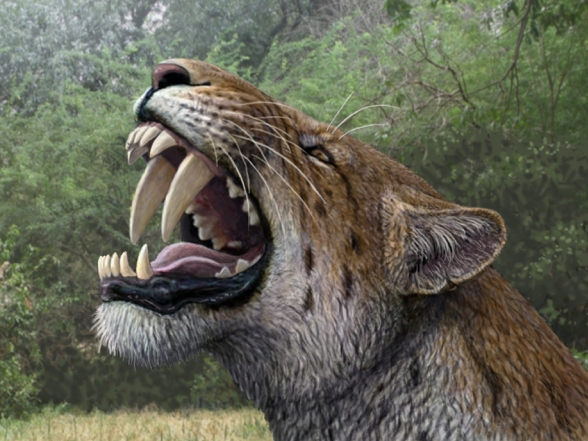News
12.04.2017
Successful Dig Reveals an Almost Complete Skull of a Saber-toothed Cat
A third individual saber-toothed cat was discovered in Schöningen
Research Institute and the University of Tübingen, the excavation team found the remains of a saber-toothed cat at the archeological site in Schöningen. An examination of the skull fragments at the Dutch University of Leiden revealed the animal to be a representative of the European saber-toothed cat, Homotherium latidens. The recent discovery constitutes the third example of this large predatory cat from Schöningen.
Long claws, razor-sharp, curved canine teeth and the size of a fully grown lion: the saber-toothed cat (Homotherium latidens) was a competitor as well as a dangerous predator that even posed a risk to the humans of its time. “In the course of our excavation in May 2015, we came across conspicuous bone fragments,” explains Dr. Jordi Serangeli, a scientist at the University of Tübingen and the excavation leader at the approximately 300,000-year-old archeological site, and he continues, “In total, there are three individuals of Homotherium present in these relatively young sediment layers.”
Until the first discovery of a saber-toothed cat in 2012 at the Schöningen excavation site in Lower Saxony it had been assumed that the large cats were already extinct about 200,000 years earlier, i.e., around 500,000 years ago. “Our findings show that 300,000 years ago, the saber-toothed cats were not as rare as previously thought,” adds Serangeli.
During a restoration in 2016, André Ramcharan and Ivo Verheijen at the University of Leiden were able to reassemble the eleven bone fragments into an almost complete neurocranium. “We then compared the reconstructed skull with recent and already extinct species of large carnivores and were thus able to demonstrate that the remains represented the head of a European saber-toothed cat,” explains Professor Dr. Thijs van Kolfschoten of the University of Leiden.
The third saber-toothed cat specimen that was discovered offers a great potential: thanks to the excellent level of preservation at the Schöningen dig, the interior of the skull reflects the shape and structure of the Homotherium brain. By examining the detailed brain structures, the team of scientists hopes to gain insights into the visual and hearing abilities as well as the feeding habits of the large cats. “The third Homotherium from Schöningen is invaluable for our understanding of the European saber-toothed cat,” summarizes Professor Nicholas Conard of the Senckenberg Centre for Human Evolution and Palaeoenvironment and head of the Institute for Early Prehistory and Quaternary Ecology at the University of Tübingen.
In the near future the international team from the Schöningen project intends to publish the results of its interdisciplinary studies regarding the three saber-toothed cats discovered to date. “Moreover, we expect that future digs will produce additional Homotherium finds,” offers Serangeli as a preview.
The dig in Schöningen keeps a team of ten members employed fulltime – and during the main excavation season, the team is joined by five to ten students, who support the scientific excavation. Worldwide, about 50 scientists from 30 institutions and a wide variety of disciplines are involved in researching the discoveries from Schöningen. The dig is financed by the State of Lower Saxony.
The spectacular new discovery is put on display for the public at the palaeon in Schöningen as part of the special exhibition “The Ice Age Huntress.” Thanks to the close cooperation between Senckenberg, the international partners and the der palaeon GmbH, it is possible to make spectacular scientific findings available to the public in a timely manner.
 | In-situ position of a skull fragment from the third Homotherium, which was discovered on 25 May 2015 at the archeological dig in Schöningen. © Univ. Tübingen / Senckenberg |
 | The reconstructed neurocranium of the European saber-toothed cat. © Univ. Tübingen / Senckenberg |
 | Artistic rendition of Homotherium latidens. © Mauricio Antón |
 | Technician André Ramcharan (University of Leiden, Netherlands) compares a find with the cast skull of a Homotherium. © University of Leiden |
 | The bones were initially scanned, restored and subsequently reassembled with the aid of a computer. © University of Leiden |
Contact:
Dr. Jordi Serangeli
Universität Tübingen /
Senckenberg HEP
palaeon 1
38364 Schöningen, Deutschland
<link>jordi.serangeli@uni-tuebingen.de
Phone: 0178 9219630
Judith Jördens
Press Office
Senckenberg Gesellschaft für
Naturforschung
Phone: 069- 7542 1434
<link>pressestelle@senckenberg.de
To study and understand nature with its unlimited diversity of living creatures and to preserve and manage it in a sustainable fashion as the basis of life for future generations – that has been the goal of the Senckenberg Gesellschaft für Naturforschung (Senckenberg Nature Research Society) for almost 200 years. This integrative “geobiodiversity research” and the dissemination of research and science are among Senckenberg’s primary tasks. Three nature museums in Frankfurt, Görlitz and Dresden display the diversity of life and the earth’s development over millions of years. The Senckenberg Gesellschaft für Naturforschung is a member of the Leibniz Association. The Senckenberg Nature Museum in Frankfurt is supported by the City of Frankfurt am Main as well as numerous other partners. Additional information can be found at <link http: www.senckenberg.de>www.senckenberg.de
The University of Tübingen is one of eleven German universities that received the recognition of excellence. Within the field of life sciences, it offers cutting-edge research, microbiology and infection research as well as molecular biology. Additional focal areas include geological and environmental research, archeology and anthropology, language and cognition as well as education and media. More than 28,400 students from all over the world are currently enrolled at the University of Tübingen. They can avail themselves of a wide spectrum of approximately 300 study courses – from Egyptology to Cellular Neurosciences.
Leiden University is an internationally oriented, research-driven university offering high-quality research and academic teaching in the arts, sciences and social sciences. Leiden University has a staff of 5,500 and a student population of 25,800.

